Latest addition (War Time) 26th March 2016.
Bob Simmons sent these three stories. He joined the BBC at Tatsfield in 1941, aged 15, and these tales date from his spell in Broadcasting House Control Room in 1943.
One day I was on Home Continuity with the announcer sitting next to me when suddenly the quality of the sound deteriorated violently and started fluttering. The announcer and I looked at each other a bit stunned, and he immediately said he would make an apology and dashed into the studio, sat in front of the microphone, looked at me and gave me the thumbs up. I faded out the programme, faded up his mic and gave him the red light. He made an apology and I mixed to standby music (Bow Bells).
The announcer came back out and just at that moment the SME (Senior Maintenance Engineer), Charlie Challis, came in to see what was up and he and I, at the same time, reached out to throw the toggle switch which changed the speaker from Radio Output Brookman’s Park (BP) to Studio Output, and the problem disappeared. The announcer then went back in to the studio, said the trouble had been cleared and we went back to the programme.
What had happened was that two engineers had gone up to the top floor of Broadcasting House and switched on the small local transmitter on the Home Service wavelength (203 meters). It was slightly off frequency with BP and caused the severe fluttering on the difference frequency. We normally always listened to the programme output from the BP transmitter and the first thing I should have done was immediately switch from receiver to local Studio Output. In my defence, I had previously spent a year at Tatsfield where one of the routine jobs was monitoring and logging all the jamming which the Germans were putting on our programmes to Occupied Europe, one of which was a multi-tone flutter, and this sound was very similar. I got criticised for not immediately switching to Studio and seeing there was no fault on our output. But the two engineers got even more severely reprimanded for not having warned the SME or SCRE (Senior Control Room Engineer) that they were going to switch on the local transmitter. The fault must also have affected any local London receivers that had been tuned in to the Home Service at that moment.
......
Another incident on Continuity was when we had received a security circular warning us that some of our programme lines ran close to the Ministry of Defence lines and some telephone conversations had been picked up by induction on our programme lines. We were told that if any were detected we should immediately switch over to standby routine. At the same time we were periodically transmitting “fuel flashes”, as they were called, urging listeners to save fuel. One of these was in the form of a telephone conversation. When my colleague heard this particular fuel flash he immediately switched over to standby routine, thinking he had intercepted a secret MOD conversation, and sat back with smug satisfaction, awaiting a pat on the back. Instead he got a telling-off for not realising it was a standard announcement!
......
Another operational error occurred on an Outside Broadcast insert from the Paris Cinema. Routinely, all inserts were identified before transmission by the OB operator going from the Control Room down to the stage or studio and saying into the microphone “Hello, this is the Paris” three times, then going back up to the Control Room and on the control (phone line) ask: “Was that OK?”. Mostly this worked but occasionally the Continuity operator was busy and asked for it to be repeated. The OB operators found a quick way of overcoming this by switching their phones into the programme line by throwing a toggle switch on the OBA8 amplifier, ‘identing’ by phone and then switching back the toggle to reconnect the microphone to programme line. One day the OB engineer forgot to switch back the mic to line and when the transmission time arrived there was dead silence and then a phone voice on transmission saying “Are you getting me OK?”!
Bob Simmons.
I remember one Easter Sunday, when, at 0900 (just at the end of a night shift) Light Prog was to SB Home Service, which was to carry Big Ben followed by an Easter address. I was in Light Con, and I was kidding the Home Con operator that he would forget to cancel the 0900 GTS, and put it out over Big Ben.
Come the event, in Light con I duly faded up Home Service - and got Big Ben plus GTS. I put down the intercom and laughed "Told you you'd forget, I said". The man in Home claimed it was "All Right Leaving Him". To my horror I then realised that the GTS I'd put out came from my own GTS selector. I hadn't worked out that I should also have cancelled the GTS! - Mike Benson
In "Sound and Television Broadcasting - General Principles", K.R. Sturley says of a BH con "It is, of necessity, more versatile than a Regional continuity suite (or those used in External Services) and it can, when desired, be used as a production mixer and for the replay of tape recordings." This book was first published in 1961 and thus must have been written before the Type B cons were in service even though it gives the impression that they had been in service for some time. Indeed there is talk of TR/90 tape m/cs even though the cons started with Leevers-Rich. The only time that I recall of use as a production mixer was on Home for cricket reports at 1215 I think. The duty announcer was the presenter, an OB producer would attend and the routine was a quick report from match 1, 6 mins or so from match 2 who then cued straight to match 1 for his long spot then back to match 2 for a summary and then a back anno from the announcer. I remember that a certain elderly female continuity operator who usually "had a slight preference for eating at 1300" used to regularly "have a slight preference for 1200" if she was in Home con during the cricket season. - Barry Taylor
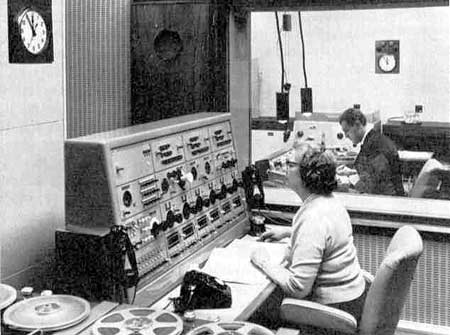
My story involves a broken tape joint. It happened at the start of "The Dales" when I was the con op in Radio 2 or was it Light Prog then? My tape op leapt back in horror, and I had to jump up and feed the tape onto the floor. When I got the machine settled and happily playing onto the floor I told him to take over - he was, after all, the tape op! Then the news sub came in with the news summary. It was a slack news day so he added to the script "The programme you just heard was saved by....quick thinking...." - and then named my tape op. The lucky chap got his photo in the papers (and the quote "I'm not a Dales fan, but my mum is"). I was a bit miffed!! - Mike Benson
I was in Home Continuity one day and was warned that a 30 minute recording had more tape edits than usual - all quarter inch tapes were physically cut during editing in those days. I therefore took the precaution of spooling through the tape to check for sticky edits. Despite this, about 10 minutes into the transmission of the tape a bad sticky join came through which sent the compliance arms of the Studer C37 into huge oscillation and promptly stopped the machine. Quickly I restarted it but a little later another join broke after the capstan so, holding the compliance jocky manually, I fed the rest of the programme off into the waste bucket conveniently close to hand (or foot!). The show must go on!
I later discovered that there were 206 edits in that half hour programme, mostly caused by one of the speakers having a bad speech impediment so necessitating many pauses and stutters having to be removed by the tape editor. - John Hale
A Radio 2 announcer (from New Zealand) used to make a speciality of telling jokes during the shipping forecast. This was on R2 in those days, before the frequency changes. It came from mixer 1A which was then in use as Radio 2 continuity. He would turn his mic off after one line, hold the talkback key down and tell a line of the joke and so on. His timing was excellent, the forecast and the joke finished at the same time. He must have spent hours rehearsing it. The talkback in 1A was of very good quality, I think it was a prefade feed from the main D202 mic. Someone decided one night that this must be recorded for posterity and paralleled the talkback and the transmission output. This was unbuffered - need I say more! - Russell Hedges
We Continuity Operators, like the Announcers, had the luxury of an overnight bed. Trouble was that the bedrooms were across the road in the Langham. Previously it was an hotel (to which it has again reverted) but in the middle of the night with no one around, it was a creepy place with many reports of the Langham Ghost ringing telephones, squeaking and banging doors and 'floating' along dark corridors. - John Hale
The Langham is home to several ghosts. One is thought to be of a German prince who, according to legend, jumped from a fourth floor window in the early years of the 20th Century. Another is a grey-haired Victorian dressed in a cloak and cravat with blank staring eyes - the spirit of a doctor thought to have killed himself after murdering his bride during their honeymoon.
The most haunted room is 333. One night, announcer James Alexander Gordon awoke in this room to see a fluorescent ball which began to take human shape....... - R.B.
One of the old school of Radio 3 announcers used to eat a full breakfast
on the announcers' desk while playing discs into the early morning show.
If you turned up the LS5/1A (the main mono monitoring loudspeaker) you could
hear him cutting the bacon coming over the turntable! You couldn't hear
it when monitoring in stereo because we used Goodmans Maxims - very small
speakers with no bass response. - Russell Hedges
It was, I think, the same announcer who often either mistakenly played
the wrong track of an album, or knocked the record with his newspaper, such
that he rarely knew quite what he'd played. He could often be seen moving
his head around reading at the label as the record turned, trying to find
out what to say he'd played! Many a time the pips were cut because the track
was 'mis-timed' due to such events. - John Westbury
I recall being told very early on in my career that when playing in the
taped inserts for Dwight Wylie on Night Ride (midnight to 0200 on Radio
2) the cue to start the insert was for Dwight, who nearly always did his
programme in 1A in near total darkness, to flash his pearly white teeth.
Dwight Wylie was a jovial Jamaican announcer, and one of the nicest people
you could ever meet. Those days of 10.5" reels of inserts played on trollied
EMI TR90 machines still live with me, as I'm sure they do for many an ex-TO!
Were they better than the old Leevers-Rich? I was never sure! - John
Westbury
During my last week at the BBC I howled the whole Open University network. It used to go out on R3, VHF only, after close down and there was some complex switching to seperate the MF transmitters, not sure why they bothered with that! I certainly didn't understand it and faded myself up and couldn't understand why the PPM went to 6 with hardly any sound every time I did this. The ATOM (Assistant Technical Operations Manager) was asleep and didn't understand what I had done either! The programme started only ten minutes late and do you know there was not a single complaint. - Russell Hedges
I joined the BBC as a Direct Entry Engineer with no background in broadcasting at BH in May, 1967 and was shortly afterwards thrown into the maelstrom as the Control Room and Cons were being converted for the new (to the BBC) concept of self-op programmes which were to sustain the new Radio 1 service.
With the imminent introduction of the Marine Offences Act which was to put the pirates out of business the BBC was obliged to provide, at quite short notice, a new pop music service. Early in 1967 the realisation dawned that if Radio 1 was to originate from the Cons, the most practical solution to the problem, this new service would need two studios if hot seat change-overs were to be avoided. A spare continuity studio would have to be built to cope with a failure in any of the domestic continuities including either of the Radio 1 (former continuity) studios, Con A and B.
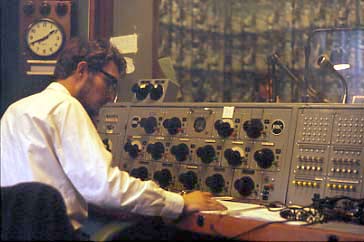
Photo - Derek Windebank
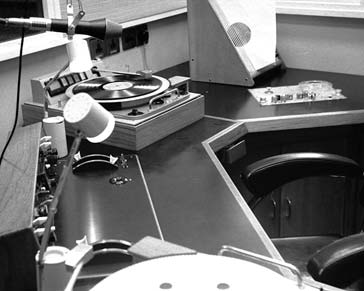
I was teamed with Johnny Longden (his memories appear below) who was responsible for Special Projects within the Central Maintenance Unit (CMU) and between us, with the indispensable help of the Langham woodwork shop and the BH mechanical and wiring workshops, we created Con G beside the TOM's office in the Control Room. The adjacent Dispatch Position was to act as its control cubicle and in the space of about nine weeks, including building work, the project was completed. Though small due to restrictions of available space the mixer was comprehensive and used the relatively new range of transistorised amplifiers.
I was then dispatched off to Wood Norton for three months to learn all about broadcast engineering! - Robert Smith
Robert's black and white photos, right and below, show the desk shortly before it entered service.
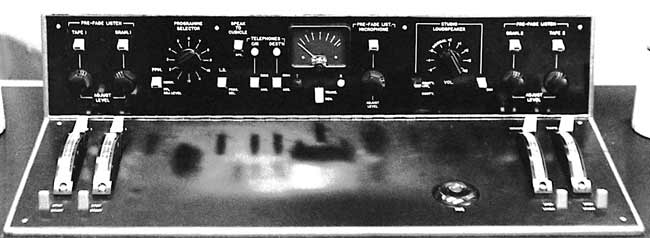
This was a fascinating challenge, since it was the earliest days of 'self-drive'. Some DJs welcomed it, others were wary of it - or even scared stiff!
Knowing everyone would have their own idea of the best desk layout, I persuaded the marvellous team of carpenters in the Langham basement workshop, under George Bow (a 2LO veteran), to make a mock-up desk with wooden shapes representing the then new quadrant faders. The desktop was a hardboard sheet, and the D-shaped pieces of wood were placed - but not fixed - where I thought they should be.
I then invited as many of the newly-appointed and would-be DJs as I could contact, to come and sit at the desk, and move the models around to their preferred positions. The mic, gram and tape faders, the PPM, various switches and buttons all had to be tried and agreed. The DJs were also asked for their opinion on the height of the desk, and the reach.
Each one, having completed this exercise, was asked to sign the hardboard model. Surpringly, most agreed to the eventual layout - and duly signed. I have wondered for years what happened to that hardboard desktop with its unique collection of autographs.
The model was used to assist in the making of the actual desk, and was then broken up - but if only I had realised the historic - and probably financial - value of that desktop! Did anyone hang on to it? Does it still exist? It would be a marvellous find. Names I remember were: Stuart Henry, Keith Skues, Emperor Roscoe, Tony Blackburn, Alan Freeman, but there were many more.
On the actual desk, the tape machine was a customised Nagra portable. The desk itself was semi-portable, since we knew 'Con G' was temporary accommodation. My original design was built with standardised 24-way Painton plugs and sockets with the idea that in the event of a fault, the entire desk could be unplugged and replaced with another one in a very short time. I got as far as a second wooden frame being made, but the budget ran out when it came to purchasing the components.
I was very amused to read all sorts of comments in technical magazines, discussing the difference between BBC and commercial practice for sound faders years later, where various theories put it down to "not knocking the script pages as one fades out…", etc. Why I didn't join in the correspondence I can't remember - but you've read it first here.
Personally, I much prefer our old steam radio 180 degree rotation faders, with their large and ergonomically correct knobs. Will they ever come back, I wonder? They should! - Johnny Longden
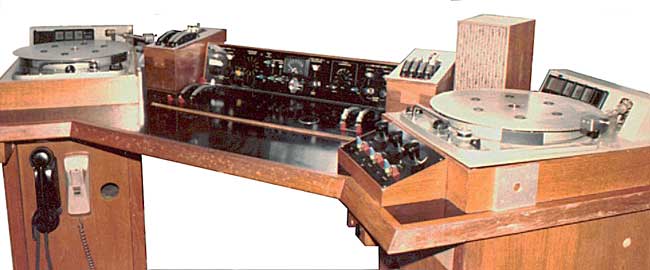
With the launch of Radio 1 also came the introduction of the 'jingle machine' in the form of the Spotmaster which used an endless loop of 1/4" tape in a NAB cartridge. Apart from all the jingles such as the famous "Radio 1 is wonderful" there were trails and promos for transmission which were transferred from the original tape to carts in the Cartridge Transfer Suite on the 2nd Floor of BH Extension which were then to be played on air by the machines in the studios.
At some point after the launch of Radio 1 many of the carts began to stop on-air suddenly, apparently at random, just after starting - much to the annoyance of the presenters several of whom passed off the malfunction on-air with a joke but were privately livid that such a simple and recurring problem should make their shows sound so unprofessional.
On test all the cartridges invariably played successfully on the machines on which they had been recorded. In response to the frequent Engineering Fault Reports (EFRs) during the preceding months the action of the maintenance engineers, and I was one of them, had been to simply change the machines either in the studio or the Transfer Suite; there seemed little other option open to us. The result was usually noted in the maintenance log as a successful fix due more to optimism than evidence!
I resolved to do something about this small but intensely annoying fault! The machines would stop playing the endless loop of tape in the cartridge by detecting a short pulse of 1 KHz tone at the start of the recording which was on a separate Cue Track. The detecting circuit was defeated for about one second after the press of the Play button to avoid the tape stopping until the tone had gone by the rep head on its first pass. Think of it, if you like, as a model train leaving the station and completing a circular layout. The delay allowed the guard's van to pass the end of the platform before the signal turned to red but would stop the front of the train as it came round again! None of the tones was heard on air, of course.
The fault was compounded by the fact that there seemed to be no consistency to it. Provided each record and playback machine conformed to the NAB spec interchange of carts between machines should have been possible without any problems. Rola Plessey replay cart machines had been installed into the on-air studios in previous months and I began to suspect that problems only occurred on certain carts and most seemed to come from the CTS on the second floor. It didn't take long for me to discover that the Spotmaster machines were recording rather longer Cue pulses than was specified although it didn't prevent successful playback on those machines when the recordings were checked by the engineers in the Transfer Suite.
The Spotmaster which was invariably used to record the trails on the second floor relied on a 1 KHz oscillator whose death throes, sustained by a simple reservoir capacitor and resistor network, formed the 'stop pulse' as the tape was started in the record mode. Unfortunately it took slightly longer to die than the delay built into the Rola Plessey replay machines in the studio. This caused the studio machines to stop just after starting when it detected the remains of the stop tone of any cart which had been recorded on a Spotmaster. Simply reducing the value of the CR network in the Spotmaster recording machines shortened their Cue pulse sufficiently to allow uninterrupted replay on other machines. Thus the problem, which had caused much embarrassment and annoyance for several months in certain circles, disappeared overnight! - Robert Smith
...or Browncoat Diagnoses Long-Standing Problem
On several occasions it was investigated by the maintenance team, found to be working normally and signed off as NFF (no fault found). The telephone cord to the hand-set was extra long so that it could reach more distant equipment in the cubicle and was plaited with artificial silk insulation as phone cords in those days frequently were.
Then one night in the small hours as I and my colleague were doing the scheduled routine maintenance - even Radio Three wasn't 24 hours then - a cleaner came in to also do his bit. Having dusted around he began to vacuum the carpet. Suddenly I was aware that his machine had dropped an octave and he was tugging at something roughly which had got sucked up: the machine still running.
I looked round and witnessed that the C/L phone cord which, due to its extra length, inevitably rested on the carpet was being extricated and on closer inspection discovered that the rotating beaters had stripped the art silk insulation down to the conductor in many places. Problem solved! - Robert Smith
In the late 60s Radio 2 was always opened up after the 0200 daily close down by Breakfast Special presented by John Dunn, a real broadcaster's broadcaster, during the week and by Bruce (Windbag) Wyndham, a most affable chap, on Saturdays. The programmes came from Mixer 1A which by then was regularly used as a continuity studio and from where self-op programmes could also originate.
One Saturday as I was driving in to BH from Chiswick for the maintenance day shift (I seem to remember I was able to park in BH car park at weekends) listening to Bruce I could hear things beginning to go wrong. Apart from a few discs his programme consisted largely of session tapes played in the cubicle from remotely started trolley-mounted EMI TR 90 tape machines.
His operator behind the glass was clearly wrestling with some unco-operative tape machines with tracks not appearing on cue, running slow and other, long forgotten, faults such as the news or traffic reports failing to appear possibly as the result of the confusion caused by the apparently recalcitrant tape machines. At one point I clearly remember Bruce saying that he would play a track and then tell us what it was afterwards when either he or the operator had managed to get it to air and identified it! They were clearly having major studio problems. The programme was what nowadays might be called a car crash and I knew what the first job of the day would be when I got in to work!
At the start of our shift we duly went up to Mixer 1A and there we found tape machines, there must have been half a dozen, all over the place including in the corridor of the Continuity Suite area and a fistful of EFRs in the book in the cubicle. Some machines had been commandeered from adjacent cons in an attempt to keep the programme going during the crisis. Bruce and the staff had gone off, to quote a later well known veteran R2 presenter, to lie down in a darkened room!
The tape machines were wheeled away for repair while two or three of us maintenance engineers set about checking out the rest of the studio.
Intermittent transmission in the programme chain and the failure of some fader/remote starts seem to have been a major cause of the problems although a couple of the TR 90s were later found to have had faults.
Having checked every tag and soldered those where necessary we repaired to the canteen and mused on how tenuous the manner in which many broadcasts had remained on air for so long! - Robert Smith.
I was a TO in BH in the sixties. I had been working in H58, the tape replay room, replaying tapes to producers, when I became confused by a tape I had to play; after lining up the tape with the normal line-up tone, a second line up tone appeared, very wavery and at an odd level.
I tried unsuccessfully to line up the machine with this second tone, and was about to escalate the problem, when I allowed the tape to continue and discovered that the second tone was in fact the introductory music for a production of Rudyard Kipling’s story “Kim”! Played on an ethnic flute, it was snake charming music – quite close (but not close enough!) to 1000 Hz line up tone…
We all had a good laugh at this, but by sheer luck I was Tape Operator in Home Con when the tape was broadcast – peak listening, Saturday night play… Needless to say, I lined up the machine correctly and played the first tape without incident, and performed the tape changeover to the second tape. (Saturday night play was, I think, 90 minutes – 3 full spools of tape.)
The senior operator asked me what I found so amusing, so I related the story, not fully paying attention to what I was doing. Both tape machines were running immediately after the changeover – the finished tape faded down and running blank tape. Unfortunately, I stopped the live machine… After a brief panic, I rewound the tape, restarted the machine, faded it in again, and the un-natural silence was broken!
Questions were asked, and I was told that I was allowed 3 such events in a year before executive action would be taken! - Roger Yeates

